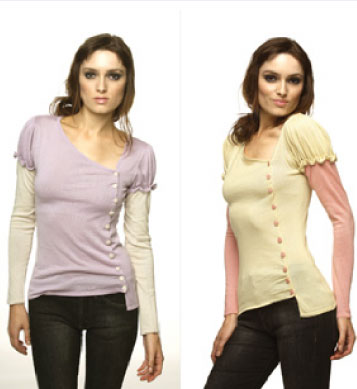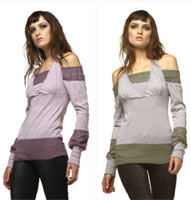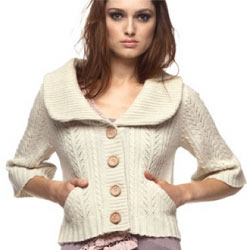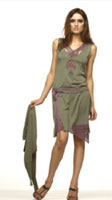| Amanda Shi – Designing Outside the Box with Eco-Friendly Avita Line
Avita is not only breaking out of conventions, but is also showing the fashion world that there are an infinite variety of ways of wearing cashmere and bamboo. In an attempt to help the environment, Amanda Shi of the Avita line did something outside of the box. She came up with a way to recycle cashmere and bamboo and create trendy wearable designs. Her inspiration for such a venture came when she purchased eco-friendly clothes from Whole Foods. She thought it would be a nice thing to expand on that idea and make eco-friendly clothes hip and trendy. Shi’s initial marketing plan was designed for women from the ages of 25 – 40, but she soon realized that her designs reached far beyond that demographic. Teenagers and their grandmothers wear her clothes. Having been featured in OCEAN, Justine, Item, Stylephile.com,Audrey, Apparel News, STAR Magazine; and worn by Andrea Bowen, Jennifer Love Hewitt, and Teri Hatcher, just to name a few; Amanda Shi has created a brand that has been embraced by the media, celebrities, and consumers. The inspired, purpose-driven designs not only aid in protecting the environment, but help to create a fashion statement. And Avita has forged a trend that is rapidly gaining momentum. With Avita, Amanda Shi has revolutionized fashion by providing cashmere and cashmere silk blends as everyday wear. She also introduced bamboo as a breathable, stylish fabric. Her current collection features an interesting pallet, which includes sand, topaz, mushroom, lavender, and black. And some of the most popular designs this season feature scooped backs, split open sleeves, Russian military buttons, and dresses with wraparound strips.
Why did you decide to recycle? What was your motivation to do it this way as opposed to the more traditional way? We live in an environment that we should start caring about, and I’m not even talking about global warming. That was awfully forward thinking of you. What is it about you that would make you go to these lengths to help save the environment? Because this is my business and I love clothes. I actually have very sensitive skin too. I even used to go to Whole Foods to buy clothes because they are environmentally friendly. Most of our pieces feel like butter on the skin when you put [them] on. The cashmere and bamboo really breathe. How did you decide to use bamboo? It’s really very interesting. We were looking for organic cotton and we couldn’t find How long has the Avita line been around? The Avita line has been around for 3 years. The bamboo line has been around for a year and a half. We were one of the first to start using bamboo. Where can people find your clothes? We have them at Fred Segal in Santa Monica, and we have a current store list across the country. You can find them on our website. If you type in the zip code, you will find the store closest to you. Do you do all the designing yourself? Yes, [but] we have a team of course, and I have a design assistant, and we work together on getting the marketing research done in getting the collection out every season. Tell me about your background. How did you get involved in designing?
Did you go to school for it? I studied fashion sketching, but I never went through a full program. I studied multimedia design, which is more focused on computer graphics, and motion graphics. Do you use any of that in your marketing? Yes, absolutely. Everything suddenly came into the picture. It’s very interesting, too, because I did business first and then I did multimedia design in school. I didn’t even know why I was doing it, and now I do. (Laughs.) Somebody had a bigger plan for you. Where are your parents from? We’re from Hong Kong, and the factory is in China. We moved the factory from Hong Kong to China in the early 90s because we wanted to expand the factory and spin our own yarn, but that was when I was in Canada. What do you charge for your designs? Our long sleeves range from $69-$89 wholesale, which is about $150-$200 retail. That’s unheard of, because that’s part cashmere, right? The fine gage silk and cashmere—we did it to give you a better figure, and we like to mix materials, something like a patch, to make it more funky or trendy. Who are your buyers? What is your demographic? Our marketing plan was for women between the ages of 25 – 40 in their career, because the idea was to have women wear it during the day and not have to change at night if they go out. At this point the demographic is pretty large: girls 15 and 16 years old, up to women in their 50s and 60s. It’s kind of ageless at this point. What is the actual process of making a blouse like the one you’re wearing?
There are a lot of things we do that cannot be done by computers. For example, some things are actually patched on. So it gives it a more contemporary look, instead of just knitted with a different color. Highest High (Laughs) When I see so many orders coming in, it’s proof of what we’ve done right. Even though it is a small business still, from the design, to the office, sales and distribution. Distribution is one of the biggest things. From sampling to production, everything has to be right to get that order shipped. Lowest Low There is a problem every day. It’s hard to keep the balance. Sometimes I get so frustrated. Because I am more of a creator, I am not completely on the logical side all the time. It’s really frustrating when something doesn’t work. I just keep telling myself if everyone could do this, then the Avita line would not be special. We really have solved a lot of problems since day one. It has been a great experience. That’s because you’re doing something that is so different. Yes, for example, the bamboo—a year and a half ago, it was so hard to sell. People liked to hear about it. The buyers thought it was interesting, but they kept on moving at the trade shows. It was really disappointing. Do you ever do any of the big shows, like the Fashion Weeks? We did the Mercedes Benz Suite Shows, a runway show with Audrey Magazine this year, and we’re trying to do something once a year. We don’t do too much because we’re trying to focus on sales and we’re trying to get the editorials so we can get the brand out. Because you’re doing something that is so different and you’re paving the way yourself, you have to be patient with yourself. It’s going to take longer than somebody doing something typical. We believe that we’re doing something good to influence this industry. Where do you see Avita line in 5 years?
Do you do all the season’s collections? Yes. We are trying to stay in the eco-friendly fields. So it makes it harder, but more specific. But it’s easier to do research. We want to go global. We want to get into Europe and go back to Asia. Currently everything is in the USA? Yes, we want to do a strong foundation here and have a brand. Within 5 years we will be everywhere. What advice would you give somebody in this industry who is trying to do something outside of the box? Just go with your gut feelings and don’t believe everybody else’s opinions because people like to comment—good and bad. Take the good and leave the bad, because if you start questioning yourself, that’s what’s going to stop you. So never give up. To learn more about Avita, visit the website at www.avitastyle.com. Interview by Kaylene Peoples |





